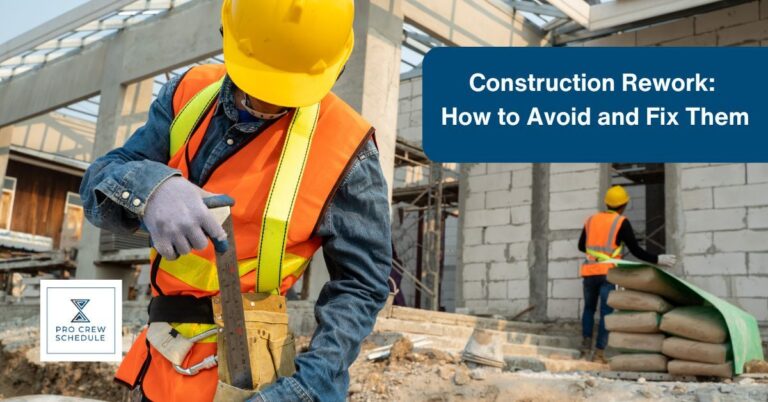When managing large construction projects, the last thing you want as a contractor is to handle costly mistakes that will force you to absorb the repair costs in your set budget.
Construction reworks inevitably happen, but they can get costly very quickly. While mistakes can arise at any phase, it’s not always easy to solve the issues when they occur in the construction operations. One small error has the potential to deteriorate other aspects of a project. Sometimes, if the project doesn’t pass a safety inspection, it must be demolished due to potential safety hazards. Moreover, construction errors can snowball and affect every project element, from the plumbing, electrical, and finishing phases.
In this article, we’ll discuss how to prepare a plan when errors occur in your projects. Furthermore, we’ll dive into the processes and tools you need to prevent construction reworks altogether.
5 Best Strategies for Handling Construction Mistakes
Following a plan of action when a construction mistake happens will allow you to address the errors quickly to limit the damage, prevent substantial rework, and guarantee that the rest of the project is finished on time. Here are five best strategies to help you get your project back on track.
Always Document Mistakes
Figuring out the root cause of an error is just as crucial as fixing it. Getting to the source of the problem is an important first step in resolution. For example, if the problem occurred because of an action of one of your workers, you could address the worker’s performance to prevent a similar situation from happening again. Yet, if the problem deals with the building materials that were used, you want to stop the rest of the team from using the same type of materials for the rest of the project.
Properly document the issue, which workers made a mistake, what materials may have been involved, and how the activity was affected. Providing a complete report of the misstep can prevent any mistake from happening again with another project. If the mistake was with procurement materials, you could find another vendor or supplier who offers better quality materials and have them shipped out immediately to prevent further delay issues in your project.
For better documentation, document the construction mistakes visually with photos and videos. While you can write a detailed description of the problem, only photos can capture it to its full extent that the rest of your team can access. Photos can be directly uploaded to the platform if you’re using construction crew management software. Therefore, the entire team can read about, view the mistakes that happened, and adapt accordingly so they won’t be repeated.
Take Accountability
You or your team members make mistakes—we’re human, after all. While it can be easier to want to avoid embarrassment and blame, this only gets back to your team moving forward. Playing the blame game at the job site, as each subcontractor and trade contractor points their fingers at each other, wastes time developing a good solution. If it’s your or your team’s fault, be professional and admit to it as quickly as possible so the construction team can move forward to find a resolution.
Accountability for one’s actions is also critical to establishing trust on the job site. Trust is vital for consistent collaboration and communication.
For some construction errors, multiple workers, contractors, and suppliers may be at fault. Figure out, as deliberately as possible, who is contractually obligated to shoulder the expenses for the issue, and then make sure that you shell out the appropriate payments as well if you are the guilty party.
Set a Construction Repair Schedule
Not every mistake in construction can be addressed immediately. Given the competitive, skilled labor field, you may not have capable workers to repair the issue at hand. You may also need to coordinate with different contractors, electricians, and plumbers who will be required to resolve the problem.
Meet with construction teams to coordinate repair works and create a schedule where the workers will be available to fix the issue. Ensure you keep your team. Especially the key stakeholders accountable for fixing the issue promptly. Then, document which type of actions will be conducted so everyone is on the same page and to avoid problems that could impact other elements of the project.
Finally, take a look at the overall construction crew scheduling. If the construction mistake was big enough, the larger construction schedule might need to be adjusted. While it is never a good situation to push project deadlines back, rescheduling quickly will help reset the project goals that your team can achieve. Ensure you coordinate with relevant stakeholders to set a new construction schedule, and communicate it immediately with teams.
Collaborate With the Entire Construction Team
Construction mistakes should never be hidden. The entire project team needs to be notified when an issue occurs and the magnitude of its impact on other aspects of the construction project.
If you fail to inform and explain the mistake to your team members, they may not be able to minimize damage as effectively or quickly as possible. Moreover, communicate with other project stakeholders and subcontractors involved. Make sure everyone understands the mistake and can move on with their respective work with minimum interruptions.
Conduct Project Risk Assessment
After repairs are completed, the issue doesn’t entirely stop there. You and your construction team should take the time to evaluate all the steps taken to manage the misstep. While this doesn’t seem like an essential step in the process, risk assessment in construction helps by allowing you to confirm that every necessary step was taken to remedy the situation in the best possible way. You can also give recommendations on how to enhance your best practices to make them more efficient if similar mistakes arise.
Best Practices to Prevent Future Construction Mistakes
What’s even better than having a proper plan of action when construction mistakes happen in your project? Not having them occur at all.
After creating the best strategy to address construction errors, if and when they ensue, you should also establish policies to avoid mistakes that could impact projects in the future. Here are a few of the best ways you can adopt to avoid mistakes from happening in the first place.
Prioritize Construction Quality
To prevent construction mistakes, teams must conduct their due diligence to prioritize the quality of their output. Standardization is one surefire method to improve quality control implemented throughout all construction stages. From standard workflows and systemized communications with team members, the right crew planning software can set your project up with uniformity. With everyone following the established quality standards, all teams will stay up-to-date with industry building codes and other specifications so each phase of the project will pass inspections.
Embrace Automation
Human error happens—it’s just natural. Generally speaking, the more people involved in a project, the higher the chance of human error. These mistakes can be reduced by automating specific tasks such as inventory management and other redundant processes. By reducing data entry errors, such as adopting automation tools that automate tasks like organizing material schedules in construction, more accurate information can be transmitted to all workers and teams.
Moreover, by adopting automation in computing and administrative tasks, you can also integrate more automation into the actual construction operations using modular construction or prefabrication. Offsite construction allows your team to use prefabricated materials built to specifications that can be placed into the rest of the project to cut down on costs, time, and human errors.
Adopt Communication Tools
When there are disconnects in the communication chain, workers can become disoriented on the tasks they need to complete and are more likely to make mistakes. Additionally, if workers fail to hear about errors that have already been created, they could produce an even bigger mess than to begin with. Hence, it’s critical to use technology solutions to improve communication between the field and the office.
Construction crew management software, such as Pro Crew Schedule, allows teams to keep in contact with updates and changes to the workflow in real-time, even with just their mobile devices. These tools can also enhance operation coordination during the construction phase of a project, so there are fewer reworks throughout the project lifecycle.
Key Takeaway
Construction mistakes can be expensive and impact future project bids, but they are preventable. Setting up a protocol for all team members to follow to address present mistakes and developing policies to address future rework can reduce project risks. Afterward, you’ll be fully prepared to handle any obstacle and set your construction projects up to run smoothly from start to finish.
Start collaborating with your with your team to reduce construction rework for the long haul. Pro Crew Schedule, with its 30-day free trial, is the perfect place to start. Don’t miss out!







